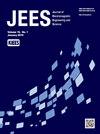亚太赫兹波折叠波导行波管放大器实验
IF 1.7
3区 工程技术
Q3 ENGINEERING, ELECTRICAL & ELECTRONIC
Journal of electromagnetic engineering and science
Pub Date : 2023-03-31
DOI:10.26866/jees.2023.2.r.160
引用次数: 0
摘要
这项研究表明,通过将X射线LIGA(一种微制造工艺)应用于交互电路,测量电路的传输特性和行波管性能,可以使用亚太赫兹行波管。应用电路类型,E端折叠波导,是最适合光刻的简单结构。总共使用了三个应用频率,即W波段、G波段和850GHz。在制造的电路中,W波段电路被应用于TWT,这是真空电子器件(VED)之一。这样做是为了通过将电路的非线性特性与预测结果进行比较来证明电路的制造精度。通过这种测试,在13.96kV和24.2-mA电子束能量的条件下,小信号增益测量为13±2dB。频率带宽非常宽,约为9GHz,并显示出与模拟预测相似的特性。通过略微增加束电流,在87.12GHz下获得了高达1W或更大的器件最大输出。这些特性成就表明了TWT适用于使用X射线LIGA工艺制造的非常小的电路,进一步表明了其他亚太赫兹波段的适用性。本文章由计算机程序翻译,如有差异,请以英文原文为准。
Experiments of Sub-THz Wave Folded Waveguide Traveling-Wave Tube Amplifier
This study showed the possibility of using a sub-terahertz (THz) traveling-wave tube (TWT) via measuring the transmission characteristics and TWT performance of the circuit by applying X-ray LIGA, a micro-fabrication process, to the interaction circuit. The applied circuit type, an E-bend folded waveguide, is a simple structure most suitable for lithography. A total of three applied frequencies were used the W-band, G-band, and 850 GHz. Among the manufactured circuits, the W-band circuit was applied to the TWT, one of the vacuum electronics devices (VEDs). This was done to prove the manufacturing accuracy of the circuit by comparing the nonlinear characteristics of the circuit with the prediction results. Through such testing, the small signal gain was measured as 13 ± 2 dB under the conditions of 13.96-kV and 24.2-mA electron beam energy. The frequency bandwidth was extremely wide, about 9 GHz, and showed similar characteristics to the simulation predictions. The maximum output of the device was obtained up to 1 W or more at 87.12 GHz by slightly increasing the beam current. These characteristic achievements showed the suitability of the TWT for very small circuits fabricated using the X-ray LIGA process, further suggesting the applicability of other sub-THz bands.
求助全文
通过发布文献求助,成功后即可免费获取论文全文。
去求助
来源期刊

Journal of electromagnetic engineering and science
ENGINEERING, ELECTRICAL & ELECTRONIC-
CiteScore
2.90
自引率
17.40%
发文量
82
审稿时长
10 weeks
期刊介绍:
The Journal of Electromagnetic Engineering and Science (JEES) is an official English-language journal of the Korean Institute of Electromagnetic and Science (KIEES). This journal was launched in 2001 and has been published quarterly since 2003. It is currently registered with the National Research Foundation of Korea and also indexed in Scopus, CrossRef and EBSCO, DOI/Crossref, Google Scholar and Web of Science Core Collection as Emerging Sources Citation Index(ESCI) Journal. The objective of JEES is to publish academic as well as industrial research results and discoveries in electromagnetic engineering and science. The particular scope of the journal includes electromagnetic field theory and its applications: High frequency components, circuits, and systems, Antennas, smart phones, and radars, Electromagnetic wave environments, Relevant industrial developments.
 求助内容:
求助内容: 应助结果提醒方式:
应助结果提醒方式:


